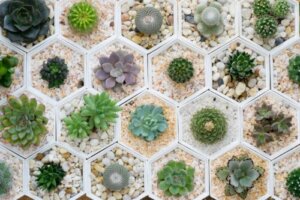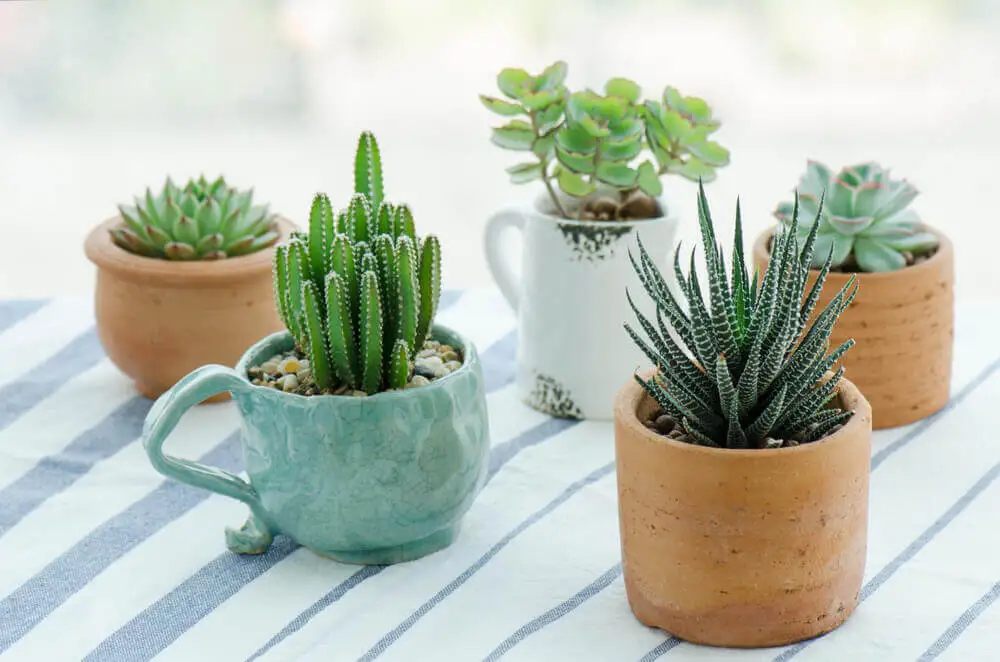6 Tips to Grow Healthy and Beautiful Succulents

Perhaps the most recognizable characteristic of succulent plants is their ability to retain water. This condition helps them to adapt to diverse environments, even hotter and drier ones than other species. Despite their resistance and easy care, we have some great tips to grow healthy and beautiful succulents.
This varied group of plants, made up of several families and genera, is also noted for its slow growth. With the following recommendation for beautiful succulents, it’s possible to accelerate the process, while obtaining healthy specimens with more intense colors.
The optimal maintenance of succulents is related to low watering frequency, cleanliness, and exposure to light.
What are succulent plants?
Succulents are a type of plant made up of a diversity of genera and families. Not all of them are genetically linked, but they do have a set of characteristics that group them together.
The most important one is their capacity to store water. Through different reserve organs, crassulas store water in large quantities.
Sometimes up to 95% of their structure is made up of this liquid. This characteristic helps them to withstand drought much better than other species. They can adapt to hot climates and to a lack of water for several days. However, they require more exposure to sunlight.
Although their care tasks are very simple, due to their great resistance and adaptability, succulents tend to experience slow growth. In addition, if you don’t pay attention to certain details, they can lose color, size, and strength. For this reason, some steps must be taken to help you grow healthy beautiful succulents.
Examples of succulents
Being such a diverse group, many plant families fall into the category. For example, the Agavaceaen Apocynaceae and Cactaceae.
The following are some of the most common succulents in homes and gardens:
- Aloe
- Cacti
- Crassulaceae
- Kalanchoe
- Agave
- Desert rose

You might be interested in: 6 Practical Tips to Make Cacti Bloom
The best tips for healthy beautiful succulents
Succulents are one of the most popular home plants. Whether for garden decoration or for indoor use, they’re very popular specimens, whose aesthetics and ease of care captivate people. However, not everyone knows how to grow healthy beautiful succulents.
1. Watering tips
Strengthening the growth of succulents requires special attention to watering. As these plants are characterized by their storage capacity, watering should be sporadic. No more frequently than every three or four days.
To further improve their conditions, water them with purified water, as scale or salts can affect their development. Some people use direct rainwater to strengthen succulents. HELP
2. Control soil moisture
Another aspect to keep in mind is the condition of the soil. For your succulents to grow healthy and beautiful, it’s necessary to use organic substrate and not common soil. On the other hand, as they have a specific storage capacity, they’re particularly affected by waterlogging.
If the soil is very wet, it’s best to stop watering for 15 days or until it’s dry again. It’s advisable to use pots with small holes to allow the water to drain. In this way, you prevent fungi from appearing.
3. Pruning so that your succulents grow healthy and beautiful
Like other species, succulents lose leaves at the time of their renewal. Therefore, a subtle pruning or cleaning of the branches should be performed. Removing weak and fallen leaves isn’t an optional task.
4. Provide adequate sunlight
Another important detail is the exposure to sunlight, which is important for these species. Otherwise, the leaves lose luster and color.
Make sure that sun exposure isn’t always direct, as this can be detrimental. Evidence that it’s getting the right amount is its annual flowering.
Succulents with healthy growth usually develop flowers once a year. Conversely, if the plant is stretching too far upward, it may mean it’s seeking sunlight, so increase its exposure.
5. Maintain brightness and growth
A tip to favor the development of healthy beautiful succulents, which is also applicable to other species, is to change the pot for a larger one. In this way, the plant knows that it has more space and continues to grow stronger.
A small pot limits its growth. However, in the case of succulents, it’s important for you to transplant during the warmer months.

6. Check the tips
The tips of your succulents can show poor care habits. If the tips are burned, then the plant may be getting too much exposure to the sun.
Another reason is that it may be in a very cold environment. To protect them from fungus, burns, and root rot, avoid placing them on a saucer, as this hinders their drainage.
Continue reading: We Recommend 6 Succulent Plants to Decorate Your Home
Quick methods to grow beautiful succulents
Apart from all the advantages of this species, you may want to speed up their slow growth a bit. To do so, put compost in the substrate during the summer months.
On the other hand, remove any cuttings that are growing alongside the plant. With them, you can start new plants, and they won’t use the soil nutrients that the main plant needs.
All cited sources were thoroughly reviewed by our team to ensure their quality, reliability, currency, and validity. The bibliography of this article was considered reliable and of academic or scientific accuracy.
- Gheribi, Rim, and Khaoula Khwaldia. “Cactus Mucilage for Food Packaging Applications.” Coatings 1 Oct. 2019. Disponible en: https://doi.org/10.3390/coatings9100655
- Andrade , José Luis, Barrera , Erick de la, Reyes García, Casandra, Ricalde , M. Fernanda, Vargas Soto, Gustavo, Cervera , J. Carlos, El metabolismo ácido de las crasuláceas: diversidad, fisiología ambiental y productividad. Boletín de la Sociedad Botánica de México [Internet]. 2007; (81):37-50. Recuperado de: https://www.redalyc.org/articulo.oa?id=57708102
- Mariani, John F. “Agave.” The Encyclopedia of American Food and Drink. Bloomsbury Publishing Plc, 2020. 20–30. Disponible en: https://doi.org/10.5040/9781635577068-0012
This text is provided for informational purposes only and does not replace consultation with a professional. If in doubt, consult your specialist.








